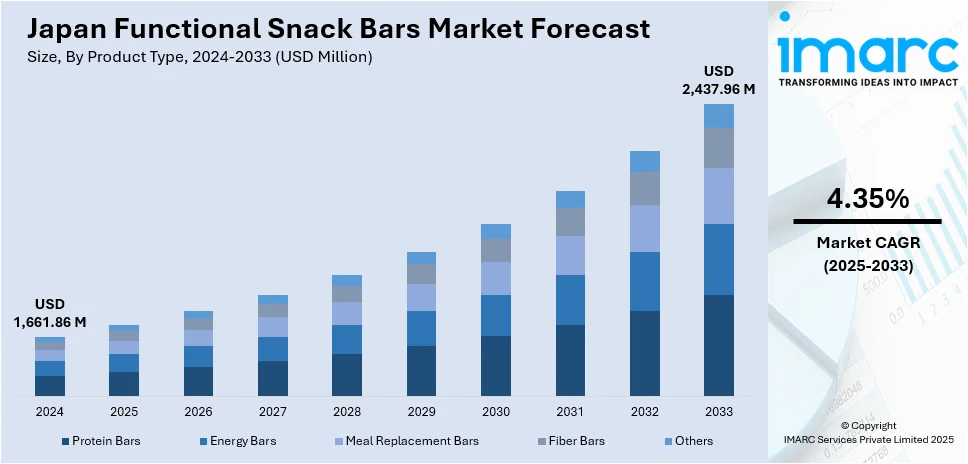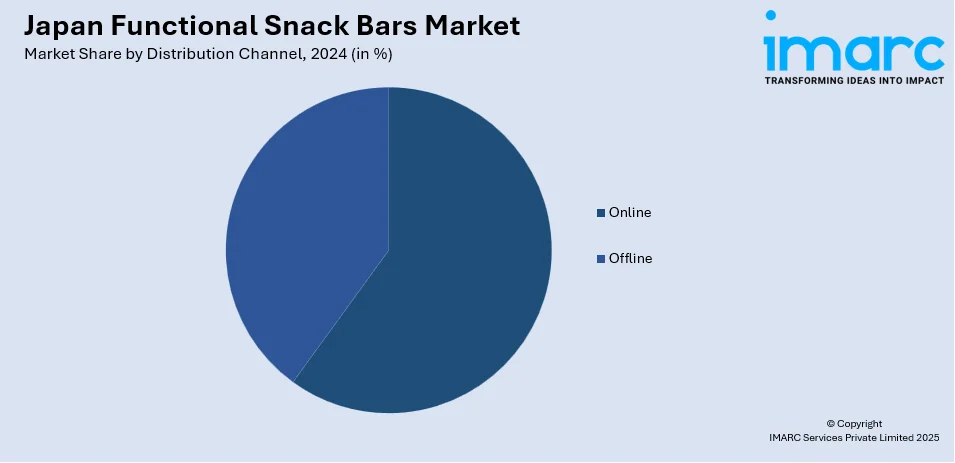
Japan Functional Snack Bars Market Size, Share, Trends and Forecast by Product Type, Ingredient Type, Distribution Channel, Price Range, Consumer Group, and Region, 2025-2033
Japan Functional Snack Bars Market Overview:
The Japan functional snack bars market size reached USD 1,661.86 Million in 2024. Looking forward, IMARC Group expects the market to reach USD 2,437.96 Million by 2033, exhibiting a growth rate (CAGR) of 4.35% during 2025-2033. At present, the growing health and wellness trends are encouraging people to seek convenient and nutritious alternatives to traditional snacks. Besides this, the broadening of retail channels, which aid in making products more accessible and visible to a wider range of consumers, is contributing to the expansion of the Japan functional snack bars market share.
|
Report Attribute
|
Key Statistics
|
|---|---|
|
Base Year
|
2024 |
|
Forecast Years
|
2025-2033
|
|
Historical Years
|
2019-2024
|
| Market Size in 2024 | USD 1,661.86 Million |
| Market Forecast in 2033 | USD 2,437.96 Million |
| Market Growth Rate 2025-2033 | 4.35% |
Japan Functional Snack Bars Market Trends:
Growing health and wellness trends
Rising health and wellness trends are positively influencing the market in Japan. As per the IMARC Group, the Japan health and wellness market size reached USD 207.28 Billion in 2024. People are becoming more conscious about their eating habits and looking for foods that support energy, immunity, digestion, and overall well-being. Functional snack bars, rich in protein, fiber, vitamins, and plant-based ingredients, match these needs perfectly. Rising disposable incomes allow more consumers to afford premium health products, including functional snack bars. Busy professionals, students, and fitness-conscious individuals are adopting these bars as part of their daily routines, using them as meal replacements or healthy in-between snacks. Brands are responding with a wide assortment of options, such as low-sugar, vegan, and fortified bars that align with specific dietary preferences. The culture of minimalism and clean eating in Japan is driving the demand for items with simple and natural ingredients and transparent labeling. Marketing campaigns are further emphasizing functionality and wellness, while endorsements from health experts and influencers aid in boosting trust and visibility. As more people are focusing on long-term health, weight management, and active lifestyles, functional snack bars are gaining popularity as a smart and easy solution in the country.

Expansion of retail channels
The expansion of retail channels is impelling the Japan functional snack bars market growth. As per the data released by the Japanese government authorities, retail sales increased by 2.8% in November 2024 compared to November 2023. Convenience stores, supermarkets, specialty health food shops, and online platforms are increasing their offerings of functional snack bars, placing them in strategic locations, such as checkout areas and health sections. This is encouraging impulse buying and generating product awareness. As retailers are diversifying their inventory, they are stocking a variety of bars catering to different dietary needs, including high-protein, low-sugar, vegan, and fiber-rich options. This variety helps meet the demands of Japan’s health-conscious and aging population. Retailers also use promotions, samples, and loyalty programs to attract customers and promote trial purchases. Online retail platforms are further expanding access by offering subscription services, user reviews, and detailed product information. Consequently, both urban and rural consumers can explore and choose from a broad assortment of functional snack bars. With attractive packaging, clear health benefits, and easy availability, more people are incorporating these bars into their daily routines.
Japan Functional Snack Bars Market Segmentation:
IMARC Group provides an analysis of the key trends in each segment of the market, along with forecasts at the country and regional levels for 2025-2033. Our report has categorized the market based on product type, ingredient type, distribution channel, price range, and consumer group.
Product Type Insights:
- Protein Bars
- Energy Bars
- Meal Replacement Bars
- Fiber Bars
- Others
The report has provided a detailed breakup and analysis of the market based on the product type. This includes protein bars, energy bars, meal replacement bars, fiber bars, and others.
Ingredient Type Insights:
- Nuts and Seeds
- Grains and Cereals
- Fruits and Vegetables
- Dairy-Based Ingredients
- Others
A detailed breakup and analysis of the market based on the ingredient type have also been provided in the report. This includes nuts and seeds, grains and cereals, fruits and vegetables, dairy-based ingredients, and others.
Distribution Channel Insights:

- Online
- Offline
The report has provided a detailed breakup and analysis of the market based on the distribution channel. This includes online and offline.
Price Range Insights:
- Premium
- Mid-Range
- Economy
A detailed breakup and analysis of the market based on the price range have also been provided in the report. This includes premium, mid-range, and economy.
Consumer Group Insights:
- Athletes and Fitness Enthusiasts
- Children and Teens
- Elderly Population
The report has provided a detailed breakup and analysis of the market based on the consumer group. This includes athletes and fitness enthusiasts, children and teens, and elderly population.
Regional Insights:
- Kanto Region
- Kansai/Kinki Region
- Central/ Chubu Region
- Kyushu-Okinawa Region
- Tohoku Region
- Chugoku Region
- Hokkaido Region
- Shikoku Region
The report has also provided a comprehensive analysis of all the major regional markets, which include Kanto Region, Kansai/Kinki Region, Central/Chubu Region, Kyushu-Okinawa Region, Tohoku Region, Chugoku Region, Hokkaido Region, and Shikoku Region.
Competitive Landscape:
The market research report has also provided a comprehensive analysis of the competitive landscape. Competitive analysis such as market structure, key player positioning, top winning strategies, competitive dashboard, and company evaluation quadrant has been covered in the report. Also, detailed profiles of all major companies have been provided.
Japan Functional Snack Bars Market News:
- In July 2024, Asahiko, the Japanese branch of South Korea's Pulmuone, revealed that its protein snack Tofu Bar reached over 70 Million units sold within three and a half years of its introduction in Japan. The Tofu Bar could be found in approximately 30,000 outlets of Japan's three largest convenience store chains, selling an average of around 70,000 units each day.
- In March 2024, dot.me, a prominent Japanese start-up, teamed up with Seven-Eleven Japan to introduce a novel health food brand called ‘Cycle.me’ in Japan. It entered around ‘Chrono-nutrition,’ emphasizing ‘when to eat.’ Understanding the optimal timing simplified the decision-making process significantly. For every time frame, the firm created items that included suggested nutrients like protein bars, snacks, and instant noodles.
Japan Functional Snack Bars Market Report Coverage:
| Report Features | Details |
|---|---|
| Base Year of the Analysis | 2024 |
| Historical Period | 2019-2024 |
| Forecast Period | 2025-2033 |
| Units | Million USD |
| Scope of the Report |
Exploration of Historical Trends and Market Outlook, Industry Catalysts and Challenges, Segment-Wise Historical and Future Market Assessment:
|
| Product Types Covered | Protein Bars, Energy Bars, Meal Replacement Bars, Fiber Bars, Others |
| Ingredient Types Covered | Nuts and Seeds, Grains and Cereals, Fruits and Vegetables, Dairy-Based Ingredients, Others |
| Distribution Channels Covered | Online, Offline |
| Price Ranges Covered | Premium, Mid-Range, Economy |
| Consumer Groups Covered | Athletes and Fitness Enthusiasts, Children and Teens, Elderly Population |
| Regions Covered | Kanto Region, Kansai/Kinki Region, Central/Chubu Region, Kyushu-Okinawa Region, Tohoku Region, Chugoku Region, Hokkaido Region, Shikoku Region |
| Customization Scope | 10% Free Customization |
| Post-Sale Analyst Support | 10-12 Weeks |
| Delivery Format | PDF and Excel through Email (We can also provide the editable version of the report in PPT/Word format on special request) |
Key Questions Answered in This Report:
- How has the Japan functional snack bars market performed so far and how will it perform in the coming years?
- What is the breakup of the Japan functional snack bars market on the basis of product type?
- What is the breakup of the Japan functional snack bars market on the basis of ingredient type?
- What is the breakup of the Japan functional snack bars market on the basis of distribution channel?
- What is the breakup of the Japan functional snack bars market on the basis of price range?
- What is the breakup of the Japan functional snack bars market on the basis of consumer group?
- What is the breakup of the Japan functional snack bars market on the basis of region?
- What are the various stages in the value chain of the Japan functional snack bars market?
- What are the key driving factors and challenges in the Japan functional snack bars market?
- What is the structure of the Japan functional snack bars market and who are the key players?
- What is the degree of competition in the Japan functional snack bars market?
Key Benefits for Stakeholders:
- IMARC’s industry report offers a comprehensive quantitative analysis of various market segments, historical and current market trends, market forecasts, and dynamics of the Japan functional snack bars market from 2019-2033.
- The research report provides the latest information on the market drivers, challenges, and opportunities in the Japan functional snack bars market.
- Porter's five forces analysis assist stakeholders in assessing the impact of new entrants, competitive rivalry, supplier power, buyer power, and the threat of substitution. It helps stakeholders to analyze the level of competition within the Japan functional snack bars industry and its attractiveness.
- Competitive landscape allows stakeholders to understand their competitive environment and provides an insight into the current positions of key players in the market.
Need more help?
- Speak to our experienced analysts for insights on the current market scenarios.
- Include additional segments and countries to customize the report as per your requirement.
- Gain an unparalleled competitive advantage in your domain by understanding how to utilize the report and positively impacting your operations and revenue.
- For further assistance, please connect with our analysts.
 Request Customization
Request Customization
 Speak to an Analyst
Speak to an Analyst
 Request Brochure
Request Brochure
 Inquire Before Buying
Inquire Before Buying




.webp)




.webp)












